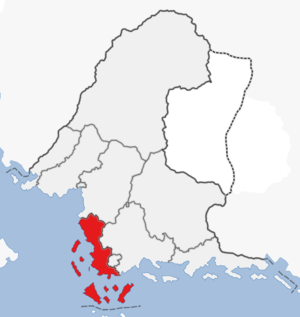Western Sanilla: Difference between revisions
No edit summary |
No edit summary |
||
| Line 16: | Line 16: | ||
| govex = Executive Council (11) | | govex = Executive Council (11) | ||
| govleg = Legislative Assembly (315) | | govleg = Legislative Assembly (315) | ||
| senate = 9 | |||
| llusan = 67 | |||
| offlang = [[Sanaman language|Sanaman]] | | offlang = [[Sanaman language|Sanaman]] | ||
| otherlang = [[Istvanistani language|Istvanistani]], [[Babkhi language|Babkhi]], [[shire:Yardistani language|Yardistani]] | | otherlang = [[Istvanistani language|Istvanistani]], [[Babkhi language|Babkhi]], [[shire:Yardistani language|Yardistani]] | ||
Latest revision as of 10:34, 28 May 2020
| Western Amarra – Western Sanilla – Central Sanilla | |
| Rrumëqe Sanilla Ate Province of Western Sanilla | |
| Capital | Port Niyi |
| Largest cities | West Niyi, Awhara, Sentora, Xalene Sitar |
|
| |
| Population | |
|
9,855,687 (1680) |
|
124.01 per km2 |
|
5 of 9 |
| Area | 79,477 km2 |
|
6 of 9 |
|
| |
| Government | |
|
Executive Council (11) |
|
Legislative Assembly (315) |
|
| |
| National representation | |
| 67 MLs | |
|
| |
| Language(s) | |
|
Sanaman |
|
Istvanistani, Babkhi, Yardistani |
| Local religion | Somanes, Cedrism, others, irreligious |
| Code | WSA |
The Province of Western Sanilla is a province in southern Sanama. The province has a population of nine million people and an area of 79,000 km2, making it the fifth most populated and sixth largest province. The province was formed in 1679 with the passage of the new federal constitution and is largely coterminous with the previous Western Sanilla region. The center of the mainland is dominated by the capital Port Niyi and its metropolitan area. The north of the mainland has swamplands along the coast, while the interior is mostly forested. The south of the mainland is dominated by rice fields and settlements. The large islands of Lakhesis and Hareffa Lunti are located off the coast to the west, with the Fig Islands to the south. The Fig islands are a popular tourist destination with several resorts and a growing adventure industry. The province is bordered to the west and south by the Cosimo Sea, to the east by Central Sanilla and Niyi, and to the north by Eastern Amarra.
Geography
Western Sanilla consists of five distinct geographical regions. The northern part of the mainland is largely covered in forest, with mangrove by the coast and a subtropical forest farther inland. The middle of the mainland is dominated by the delta of the Anilha river, whose rich marshlands are home to a wide variety of flora and fauna, among them Anilha alligator, Qaqatirri bird and the small Lho cat. The delta is also home to the capital Port Niyi, situated in a drained part of the delta. To the south the dense tropical forests are divided by farmland. The western parts of the Niyi metropolitan area extends into Western Sanilla. Off the coast to the west are the low Hareffa Lunti islands, so named because of their evergreen vegetation. To the north in the group of islands is the hilly island of Lakhesis, home to the Lakhesis goat. In the south are the Fig islands, five islands ceded by Drak-Modan to Sanama. The name comes from the abundance of both cultivated and naturally occuring fruit on the islands. The four eastern islands have sandy beaches and dense palm tree and tropical forests, while the westernmost island is more ragged with steep cliffs and exposed rock.
Economy
The northern parts of the province see limited logging and farming of mainly coconut, pineapple and mango. The deltas of the central parts are dominated by rice fields between large nature reserves, as well as the economic activity in the capital Port Niyi, headquarters of Sanama State Maritime Industries as well as the First Fleet of the Sanaman Navy, Navy Headquarters Command, the Naval Academy and the Naval Combat School. Port Niyi is also a major transport hub, serving both ocean-going vessels and fleets of barges transporting goods to and from Niyi in the shallow Anilha river. In the southern parts, banana plantations and rice fields mingle with dense forests. The island of Lakhesis to the west sees limited grazing, primarily of domesticated Lakhesis goat, while the Hareffa Lunti islands are popular tourism destinations. The Fig Islands to the south are the largest producers of fruit in Sanama.
Politics
Western Sanilla is governed by an eleven-member Executive Council elected by the 315-member Legislative Council. Both bodies serve two year terms. The province government is controlled by the Sanaman Liberation Front in coalition with Coalition 1660, the Green Alliance and the Sanaman Communist Party. The main opposition is the United Nationalist Alliance. The provincial government is marred with several issues inherited from the old Shirerithian administration, namely bureaucratic corruption, inefficiency and waste.
| |||||||||||||||||||||||


